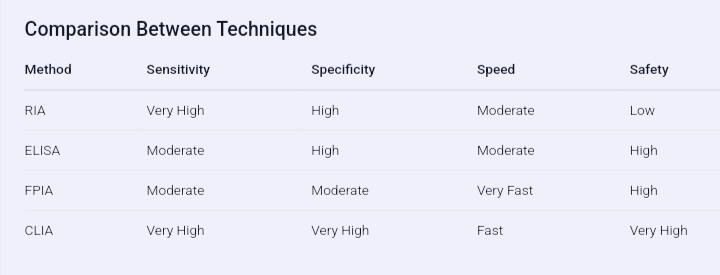
Most Important Laboratory Methods for Hormone Measurement
The measurement of hormones in clinical and research laboratories is critical for diagnosing and monitoring various physiological and pathological conditions. The most commonly used laboratory methods for hormone measurement include Radio Immunoassay (RIA), Enzyme-Linked Immunosorbent Assay (ELISA), Fluorescence Polarization Immunoassay (FPIA), and Chemiluminescence Enzyme Immunoassay (CLIA). Below is a detailed explanation of each method, including the principles underlying these techniques.
1. Radio Immunoassay (RIA)
Principle:
RIA is one of the earliest immunoassay techniques developed to measure hormones with high sensitivity. It relies on the competition between a radioactively labeled antigen (hormone) and an unlabeled antigen from the sample for binding to a specific antibody. The amount of radioactivity measured is inversely proportional to the concentration of the hormone in the sample.
Steps:
- A known quantity of radiolabeled hormone is mixed with a specific antibody.
- The patient’s sample containing the unlabeled hormone is added to compete with the radiolabeled hormone for binding sites on the antibody.
- After incubation, bound and unbound antigens are separated.
- The radioactivity of the bound fraction is measured using a gamma counter.
Applications:
- Measurement of thyroid hormones (e.g., T3, T4).
- Detection of reproductive hormones like estrogen, progesterone, and testosterone.
Advantages:
- High sensitivity.
- Suitable for detecting very low concentrations of hormones.
Limitations:
- Use of radioactive isotopes poses health risks.
- Requires specialized facilities for handling radioactive materials.
2. Enzyme-Linked Immunosorbent Assay (ELISA)
Principle:
ELISA uses enzyme-labeled antibodies or antigens to detect and quantify hormones in biological samples. A substrate reacts with the enzyme to produce a measurable signal, typically a color change that correlates with hormone concentration.
Steps:
- A capture antibody is immobilized on a solid surface like a microtiter plate.
- The sample containing the target hormone binds to this capture antibody.
- A detection antibody conjugated to an enzyme binds to another epitope on the same antigen.
- A substrate specific to the enzyme is added, producing a colorimetric signal proportional to hormone concentration.
Applications:
- Detection of insulin levels in diabetes management.
- Measurement of pregnancy-related hormones like hCG (human chorionic gonadotropin).
Advantages:
- High specificity due to dual-antibody recognition.
- Versatile format suitable for different types of samples (e.g., serum, plasma).
Limitations:
- Lower sensitivity compared to advanced methods like CLIA.
- Time-consuming due to multiple washing steps.
3. Fluorescence Polarization Immunoassay (FPIA)
Principle:
FPIA measures changes in fluorescence polarization caused by antigen-antibody interactions in solution. When fluorescently labeled antigens bind to antibodies, their rotation slows down, increasing fluorescence polarization intensity.
Steps:
- A fluorescently labeled hormone analog competes with unlabeled hormone from the sample for binding sites on specific antibodies.
- Bound complexes exhibit higher fluorescence polarization than free fluorescent molecules due to slower rotational motion.
- The degree of fluorescence polarization is inversely proportional to hormone concentration in the sample.
Applications:
- Therapeutic drug monitoring (e.g., measuring cortisol levels).
- Hormonal assays requiring rapid results.
Advantages:
- Rapid analysis suitable for high-throughput testing.
- Does not require separation steps between bound and free fractions.
Limitations:
- Limited sensitivity compared to other immunoassays like RIA or CLIA.
4. Chemiluminescence Enzyme Immunoassay (CLIA)
Principle:
CLIA combines immunological reactions with chemiluminescent detection technology for highly sensitive measurement of hormones based on light emission during chemical reactions.
Steps:
- Hormones in the sample bind either directly or indirectly with chemiluminescent-labeled antibodies or antigens forming immune complexes.
- A chemical reaction involving substrates produces light as a signal when catalyzed by enzymes linked to antibodies or antigens.
- The emitted light intensity is measured using photomultiplier tubes (PMTs), which correlate directly or indirectly with hormone concentration depending on assay design.
Applications:
- Thyroid function tests such as TSH measurement.
- Screening tumor markers like PSA or cancer-specific antigens.
- Monitoring reproductive hormones like LH and FSH.
Advantages:
- Extremely high sensitivity and specificity compared to ELISA or RIA.
- Faster turnaround time due to automation capabilities.
- Safer than RIA as it does not involve radioactive materials.
Limitations:
- Higher cost per test compared to traditional methods like ELISA.

Conclusion
Each method has its unique strengths and limitations depending on factors such as required sensitivity, specificity, speed, safety considerations, and cost-effectiveness:
- RIA remains highly sensitive but has largely been replaced by safer alternatives due to its reliance on radioactive isotopes.
- ELISA offers versatility and ease-of-use but lacks sensitivity compared to newer technologies like CLIA.
- FPIA provides rapid results but may not be ideal for detecting very low concentrations of hormones.
- CLIA stands out as one of the most advanced techniques offering exceptional sensitivity, specificity, and automation capabilities suitable for large-scale clinical diagnostics.







